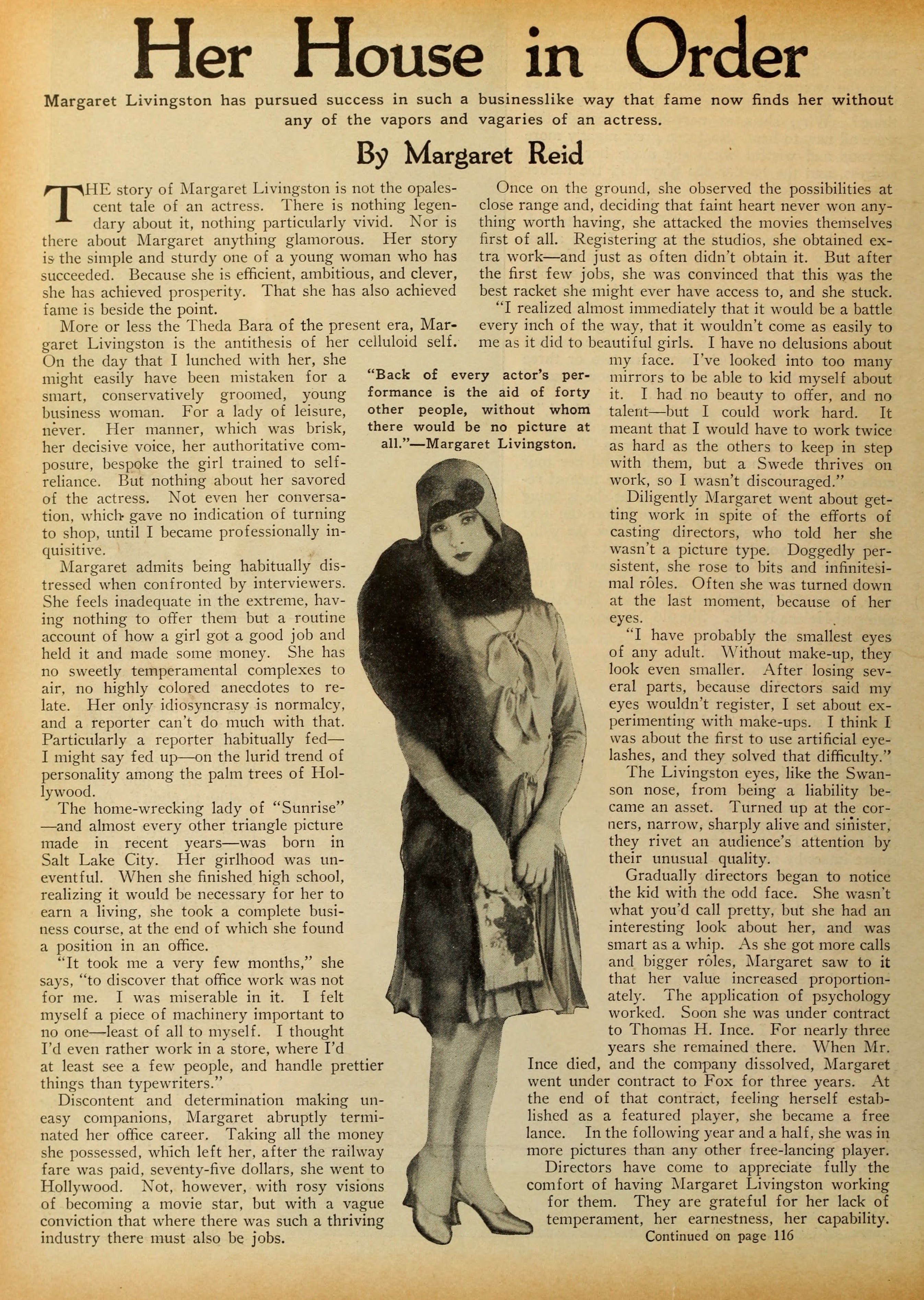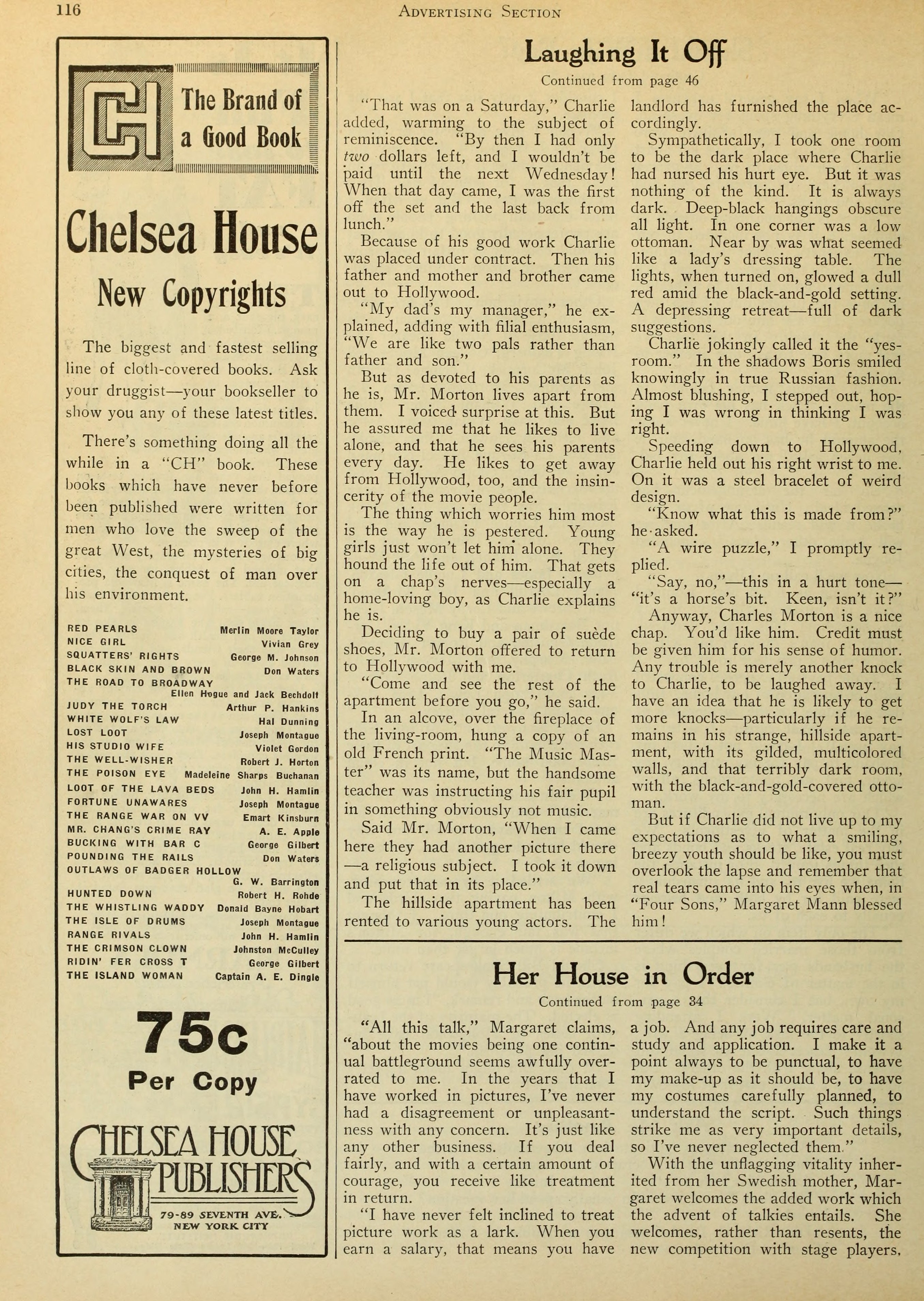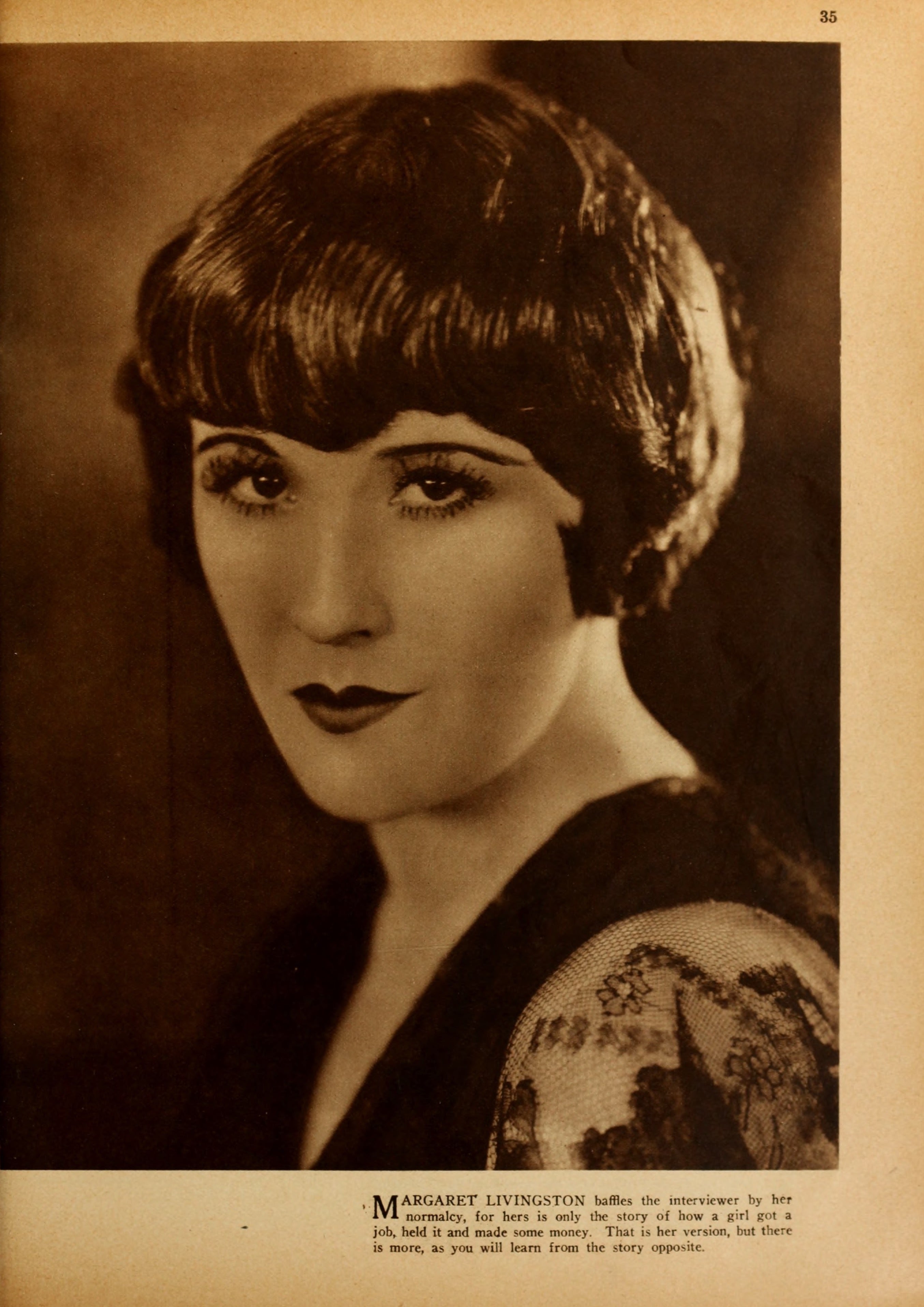Margaret Livingston — Her House in Order (1929) 🇺🇸

The story of Margaret Livingston is not the opalescent tale of an actress. There is nothing legendary about it, nothing particularly vivid. Nor is there about Margaret anything glamorous. Her story is the simple and sturdy one of a young woman who has succeeded. Because she is efficient, ambitious, and clever, she has achieved prosperity. That she has also achieved fame is beside the point.
by Margaret Reid
More or less the Theda Bara of the present era, Margaret Livingston is the antithesis of her celluloid self. On the day that I lunched with her, she might easily have been mistaken for a smart, conservatively groomed, young business woman. For a lady of leisure, never. Her manner, which was brisk, her decisive voice, her authoritative composure, bespoke the girl trained to self-reliance. But nothing about her savored of the actress. Not even her conversation, which gave no indication of turning to shop, until I became professionally inquisitive.
Margaret admits being habitually distressed when confronted by interviewers. She feels inadequate in the extreme, having nothing to offer them but a routine account of how a girl got a good job and held it and made some money. She has no sweetly temperamental complexes to air, no highly colored anecdotes to relate. Her only idiosyncrasy is normalcy, and a reporter can’t do much with that. Particularly a reporter habitually fed — I might say fed up — on the lurid trend of personality among the palm trees of Hollywood.
The home-wrecking lady of Sunrise — and almost every other triangle picture made in recent years — was born in Salt Lake City. Her girlhood was uneventful. When she finished high school, realizing it would be necessary for her to earn a living, she took a complete business course, at the end of which she found a position in an office.
“It took me a very few months,” she says, “to discover that office work was not for me. I was miserable in it. I felt myself a piece of machinery important to no one — least of all to myself. I thought I’d even rather work in a store, where I’d at least see a few people, and handle prettier things than typewriters.”
Discontent and determination making uneasy companions, Margaret abruptly terminated her office career. Taking all the money she possessed, which left her, after the railway fare was paid, seventy-five dollars, she went to Hollywood. Not, however, with rosy visions of becoming a movie star, but with a vague conviction that where there was such a thriving industry there must also be jobs.
Once on the ground, she observed the possibilities at close range and, deciding that faint heart never won anything worth having, she attacked the movies themselves first of all. Registering at the studios, she obtained extra work — and just as often didn’t obtain it. But after the first few jobs, she was convinced that this was the best racket she might ever have access to, and she stuck. “I realized almost immediately that it would be a battle every inch of the way, that it wouldn’t come as easily to me as it did to beautiful girls. I have no delusions about my face. I’ve looked into too many mirrors to be able to kid myself about it. I had no beauty to offer, and no talent — but I could work hard. It meant that I would have to work twice as hard as the others to keep in step with them, but a Swede thrives on work, so I wasn’t discouraged.”
Diligently Margaret went about getting work in spite of the efforts of casting directors, who told her she wasn’t a picture type. Doggedly persistent, she rose to bits and infinitesimal roles. Often she was turned down at the last moment, because of her eyes.
“I have probably the smallest eyes of any adult. Without make-up, they look even smaller. After losing several parts, because directors said my eyes wouldn’t register, I set about experimenting with make-ups. I think I was about the first to use artificial eyelashes, and they solved that difficulty.” The Livingston eyes, like the Swanson nose, from being a liability became an asset. Turned up at the corners, narrow, sharply alive and sinister, they rivet an audience’s attention by their unusual quality.
Gradually directors began to notice the kid with the odd face. She wasn’t what you’d call pretty, but she had an interesting look about her, and was smart as a whip. As she got more calls and bigger roles, Margaret saw to it that her value increased proportionately. The application of psychology worked. Soon she was under contract to Thomas H. Ince. For nearly three years she remained there. When Mr. Ince died, and the company dissolved, Margaret went under contract to Fox for three years. At the end of that contract, feeling herself established as a featured player, she became a free lance. In the following year and a half, she was in more pictures than any other free-lancing player. Directors have come to appreciate fully the comfort of having Margaret Livingston working for them. They are grateful for her lack of temperament, her earnestness, her capability.
“All this talk,” Margaret claims, “about the movies being one continual battleground seems awfully overrated to me. In the years that I have worked in pictures, I’ve never had a disagreement or unpleasantness with any concern. It’s just like any other business. If you deal fairly, and with a certain amount of courage, you receive like treatment in return.
“I have never felt inclined to treat picture work as a lark. When you earn a salary, that means you have a job. And any job requires care and study and application. I make it a point always to be punctual, to have my make-up as it should be, to have my costumes carefully planned, to understand the script. Such things strike me as very important details, so I’ve never neglected them.”
With the unflagging vitality inherited from her Swedish mother, Margaret welcomes the added work which the advent of talkies entails. She welcomes, rather than resents, the new competition with stage players, whom she reveres for their superior technique and knowledge.
To the cynics who don’t admit a reward for taking pains, one can point out Margaret Livingston as a most satisfactory example to the contrary. Her success has been less haphazard than that of other players.
Just as painstakingly as a broker builds up a prosperous business, so has she molded her career. Yet, although her own energy has brought it about, she is one of the few players who will admit their partial dependence on the other elements necessary to picture making. If you peruse reviews of current pictures, you will be aware that Margaret Livingston has never received an unfavorable notice. Which pleases, but does not unduly excite her.
“It is foolish to overestimate the importance of the actor. We work hard and to the best of our ability, which is what we are getting paid for. But, should a performance turn out well, it isn’t the actor’s personal and private triumph. We are only cogs in a tremendous machine, and back of every actor’s performance is the aid of forty Other people, without whom there would be no picture at all. The producer, the director, the scenarist, the camera man, the press agent, the cutter, the electrician, et cetera, are all just as vitally necessary as we are. The fact that we are the ones exploited is no excuse for getting delusions of glory.”
Her strange, undeniably lovely face may be known to several countries, her copious mail may bring adulation from near and far, her position in life may give off an aura of glamour, but these adjuncts to success she discounts, except for recognizing them as part of her business. Principally she is a girl who has not won, but earned fortune, and accepts the result of her endeavor for exactly what it is worth. Which is financial security, means to take care of her responsibilities, and a job in which she is completely interested and happy.

“Back of every actor’s performance is the aid of forty other people, without whom there would be no picture at all.” — Margaret Livingston.



Margaret Livingston baffles the interviewer by her normalcy, for hers is only the story of how a girl got a job, held it and made some money. That is her version, but there is more, as you will learn from the story opposite.
Collection: Picture Play Magazine, September 1929
